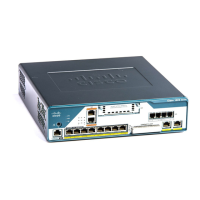The clock configuration on controller must be done before configuring the clock recovery on global
configuration mode.
Note
To remove the clock configuration in ACR and DCR, you must remove the recovery clock configuration in
global configuration mode and then remove the controller configuration.
Verifying the Adaptive Clock Recovery Configuration of T1/E1 Interfaces for SAToP
Use the show recovered-clock command to verify the adaptive clock recovery of T1/E1 interfaces for SAToP:
Router# show recovered-clock
Recovered clock status for subslot 0/4
--------------------------------------
Clock Type Mode CEM Status Frequency Offset(ppb) Circuit-No
0 DS1 ADAPTIVE 0 ACQUIRED n/a 0 (Port)
Use the show running-config command to verify the configuration of adaptive clock of T1/E1 interfaces:
Router# show running-config | section 0/0/1
controller T1/E1 0/0/1
framing unframed
clock source recovered 1
linecode b8zs
cablelength long 0db
cem-group 0 unframed
interface CEM0/0/1
no ip address
cem 0
Use the show running-config | section recovered-clock command to verify the recovery of adaptive clock
of T1/E1 interfaces:
Router# show running-config | section recovered-clock
recovered-clock 0 0
clock recovered 1 adaptive cem 1 0
Configuring DCR for T1/E1
Configuring Differential Clock Recovery of T1/E1 Interfaces for SAToP
Before You Begin
Before configuring Differential Clock Recovery, CEM must be configured. Below are the guidelines to
configure Differential clock recovery:
• Before you start configuring DCR, RTP must be enabled on the CEM interface. The RTP is used to carry
the differential time.
• The minimum packet size of CEM pseudowires on the network that delivers robust clock recovery is 64
bytes.
48-Port T1/E1 CEM Interface Module Configuration Guide, Cisco IOS XE Fuji 16.7.x (Cisco NCS 4200 Series)
34
Clock Recovery System for SAToP
Verifying the Adaptive Clock Recovery Configuration of T1/E1 Interfaces for SAToP

